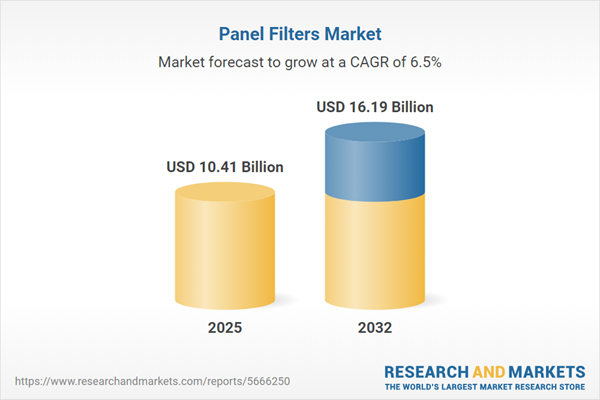Speak directly to the analyst to clarify any post sales queries you may have.
The global panel filters market is undergoing significant transformation as businesses heighten their focus on air quality, regulatory alignment, and sustainability. Senior decision-makers are seeking reliable solutions that advance compliance objectives and operational efficiency while addressing evolving stakeholder expectations.
Market Snapshot: Global Panel Filters Market Size and Trajectory
The panel filters market is poised for steady growth, with market value projected to increase from USD 9.78 billion in 2024 to USD 10.41 billion in 2025, indicating a CAGR of 6.50%. Expansion is driven by sustained demand in commercial, healthcare, and industrial sectors as organizations raise air filtration standards and deploy supply chain strategies that ensure business resilience. The global market’s adaptability enables organizations to navigate changing regulations and diverse operational needs, positioning next-generation filtration solutions as central to initiatives around air quality and resource optimization.
Scope & Segmentation of the Panel Filters Market
- Distribution Channels: Strategies such as direct sales, telemarketing, e-commerce, mobile apps, department stores, and specialty stores provide flexibility and broad market access, supporting procurement models that can be tailored to organizational scale and geographic presence.
- Product Types: Economy, premium, and standard panel filters enable leaders to match filtration performance, lifecycle, and cost control to specific operational and sector requirements, optimizing both initial investment and long-term value.
- End User Applications: Applications span hospitality venues, office complexes, manufacturing environments, and residential buildings. Both single- and multi-family residences use panel filters to meet stringent indoor air quality and process filtration goals, underscoring the sector’s wide applicability and potential for customization.
- Price Ranges: Options across low, medium, and high price tiers give organizations flexibility to align expenditure with quality or performance needs, helping procurement teams effectively balance budgets and risk management objectives.
- Sub-Regions: The market encompasses North America (United States, Canada, Mexico), Latin America (Brazil, Argentina, Chile, Colombia, Peru), Europe (across Western and Eastern regions), the Middle East, Africa, and Asia-Pacific. Each exhibits unique regulatory drivers and procurement preferences based on infrastructure maturity and environmental legislation.
- Technologies and Trends: Key trends include the adoption of nanofiber coatings, hybrid synthetic materials, depth-loading filter media, sensors for enhanced monitoring, and recyclable or energy-efficient materials. These innovations support compliance and drive operational benefits across sectors.
Key Takeaways for Senior Decision-Makers
- Advanced filtration technologies now help organizations meet evolving compliance mandates and document environmental stewardship, which can influence business reputation and customer trust.
- Panel filters integrated with sensors deliver actionable data on filter performance, enabling predictive maintenance and optimized resource management across assets and facilities.
- Sustainability objectives are increasingly supported through the use of recyclable materials and production processes that reduce environmental impact and aid decarbonization strategies.
- Varied product tiers empower brands to differentiate their offerings and develop targeted value propositions for diverse user segments and regional requirements.
- Digital management platforms facilitate proactive maintenance planning and system optimization, allowing for better lifecycle oversight and enhanced network collaboration.
Impact of U.S. Tariffs on the Global Panel Filters Market
Recent adjustments to U.S. trade policies have led buyers and suppliers to strengthen domestic manufacturing, diversify sourcing options, and explore alternatives to imported components, aiming to mitigate risks from increased tariffs. Immediate industry responses include stockpiling and prioritizing local procurement, while long-term competitiveness relies on adaptable supply network strategies and resilience measures to maintain compliance and product availability.
Methodology & Data Sources
Research insights are based on expert interviews with original equipment manufacturers, facility managers, and procurement leaders, supplemented by authoritative technical sources. All data is rigorously verified, supporting strategic decisions for organizations operating in this evolving landscape.
Why This Report Matters
- Provides targeted intelligence on technology trends and regulatory shifts to inform executive planning and ensure continued compliance.
- Clarifies competitive landscape and segmentation dynamics to aid strategic market entry and expansion initiatives.
- Details how macroeconomic changes and supply chain adaptations impact sourcing, supporting risk management and continuity planning.
Conclusion
In a market shaped by regulatory evolution and supply chain complexity, executives who prioritize innovation and resilient sourcing will reinforce operational value, positioning their organizations for sustained success in the panel filters sector.
Additional Product Information:
- Purchase of this report includes 1 year online access with quarterly updates.
- This report can be updated on request. Please contact our Customer Experience team using the Ask a Question widget on our website.
Table of Contents
3. Executive Summary
4. Market Overview
7. Cumulative Impact of Artificial Intelligence 2025
Companies Mentioned
The companies profiled in this Panel Filters market report include:- Daikin Industries, Ltd.
- 3M Company
- Camfil AB
- Donaldson Company, Inc.
- Parker-Hannifin Corporation
- MANN+HUMMEL International GmbH
- Freudenberg SE
- Filtration Group Corporation
- Ahlstrom-Munksjö Oyj
- Lydall, Inc.
Table Information
| Report Attribute | Details |
|---|---|
| No. of Pages | 196 |
| Published | November 2025 |
| Forecast Period | 2025 - 2032 |
| Estimated Market Value ( USD | $ 10.41 Billion |
| Forecasted Market Value ( USD | $ 16.19 Billion |
| Compound Annual Growth Rate | 6.5% |
| Regions Covered | Global |
| No. of Companies Mentioned | 11 |









